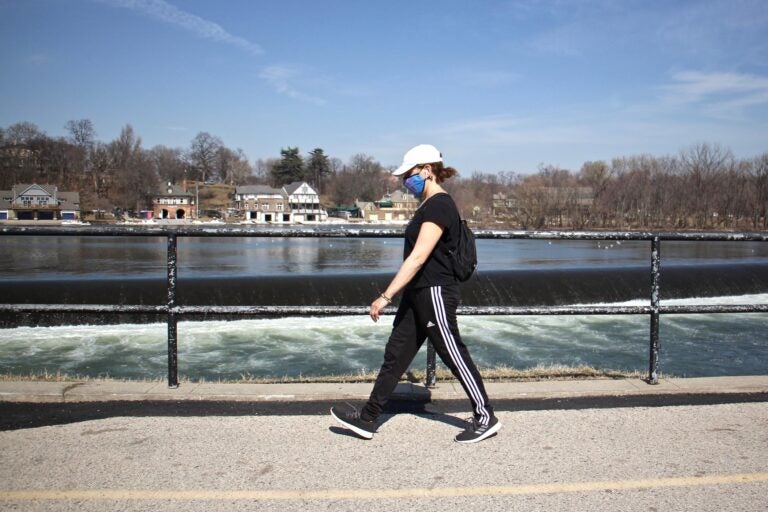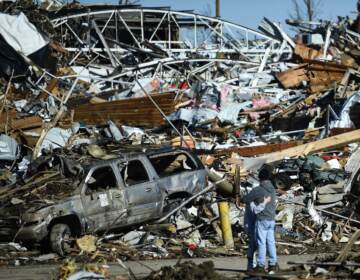Philly’s warm weekend broke records. Here’s what climate scientists say about it
Saturday’s warm weather broke records in several places throughout the Philadelphia region — and climate change likely contributed, scientists say.

Maria Becker Gallagher strolls past the Schuylkill River on Martin Luther King Drive on March 11, 2021. (Emma Lee/WHYY)
Saturday’s warm weather broke records in several places throughout the Philadelphia region — and climate change likely contributed.
Winter is the fastest-warming season across Pennsylvania and most of the United States. Philadelphia’s average winter temperature rose nearly 5 degrees Fahrenheit since 1970, according to data analyzed by Climate Central. The average winter temperature in Pittsburgh has risen nearly 4 degrees, and in Harrisburg, nearly 3 degrees.
“Winter is going away,” said Jen Brady, a data analyst at Climate Central. “Winter is really shrinking, and we’re seeing that in a large part of the country.”
Brady said scientists can’t yet say how much of this weekend’s extreme weather — which brought not only a warm day to the Mid-Atlantic, but deadly tornadoes to the South and Midwest — was caused by climate change. But Climate Central scientists say climate change likely contributed to the record warm weather seen in the Philadelphia region.
“We can say that’s probably why December in general has been warmer,” Brady said.
Philadelphia, Allentown, Reading, Trenton, Wilmington, and Georgetown broke high temperature records for Dec. 11, according to the National Weather Service’s Mt. Holly station.
Warm weather is a key ingredient in tornadoes, but research into the link between climate change and tornadoes still lags behind that of other types of extreme weather, such as hurricanes. Heat, on the other hand, is clearly tied to climate change, Brady said.
“Weather data is some of the noisiest data around,” she said. “But we do know quite well that heat is highly attributable to climate change.”
The southern half of the U.S. has been unusually warm over the past week in part due to La Niña, which brings more warm air north from the Gulf of Mexico, said Michael Mann, professor of atmospheric science at Penn State and director of the university’s Earth System Science Center.
“It’s superimposed on a trend toward ever warmer waters in the Gulf of Mexico, more warm, moist air coming off of the Gulf into the southern United States, combining with the rotation provided by the jet stream,” he said. “Climate change is certainly one of the underlying factors that we can say worsened this recent [tornado] outbreak, and there’s a clear trend in the data towards more of these very large tornado outbreaks.”
Mann said Pennsylvanians should expect more abnormally warm winter days in the future. Philadelphia is seeing on average 18 more days above normal each winter than it did in 1970, according to Climate Central. Pittsburgh sees on average 10 more winter days above normal, and Harrisburg sees on average 11 more. Climate Central compares annual temperatures in December through February to a “normal” that’s a 30-year average from 1991 to 2020.
Climate change also drives more intense wildfires, dangerous summer heat waves, sunny-day flooding from sea level rise, and flash flooding — like the Philly region experienced this year from the remnants of Hurricane Ida. Among these other disasters, warmer winters may not seem like a big problem. But Mann said this is not the case.
“While that might sound nice to some people — you know, a pleasant, warm day in the middle of winter — it wreaks havoc when it comes to our ecosystems, when it comes to plants and animals and us, and the patterns that we rely on,” Mann said. “When those patterns start to change so dramatically, it really poses a risk to all of us. And so that’s something that we do have to worry about.”

Subscribe to PlanPhilly
WHYY is your source for fact-based, in-depth journalism and information. As a nonprofit organization, we rely on financial support from readers like you. Please give today.









